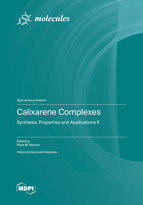Calixarene Complexes: Synthesis, Properties and Applications II
A special issue of Molecules (ISSN 1420-3049). This special issue belongs to the section "Organic Chemistry".
Deadline for manuscript submissions: closed (30 November 2023) | Viewed by 11890
Special Issue Editor
2. Faculdade de Farmácia da Universidade de Lisboa, Av. Prof. Gama Pinto, 1649-003 Lisboa, Portugal
Interests: macrocyclic and supramolecular chemistry; calixarenes; host-guest chemistry; ion binding; organic ion-pair recognition; NMR and UV-Vis absorption spectroscopy
Special Issues, Collections and Topics in MDPI journals
Special Issue Information
Dear Colleagues,
Ion recognition continues to attract the interest of researchers all over the world, due to the important role that cations and anions play in biological and chemical systems, and in the environment. Calixarenes, owing to their structural features, are one of the most widely studied supramolecular hosts. They possess a well-defined hydrophobic cavity available in different sizes and conformations, and an almost unlimited number of derivatives can be obtained by functionalization of their upper and lower rims. These macrocyclic compounds have been largely exploited as ionic and neutral molecule receptors, and present an increasing number of applications in different fields, such as organocatalysis, sensing, extraction and separation, and recently in biomedicine. Due to the high participation of the scientific community in the previous Special Issue, we decided to continue this topic. Thus, the second Issue of Calixarene Complexes: Synthesis, Properties and Applications aims to update the host–guest chemistry of calixarenes and related compounds, showing their most recent properties and applications, as well as progresses in their syntheses. Research and review articles on topics related to this field are welcome.
Prof. Dr. Paula M. Marcos
Guest Editor
Manuscript Submission Information
Manuscripts should be submitted online at www.mdpi.com by registering and logging in to this website. Once you are registered, click here to go to the submission form. Manuscripts can be submitted until the deadline. All submissions that pass pre-check are peer-reviewed. Accepted papers will be published continuously in the journal (as soon as accepted) and will be listed together on the special issue website. Research articles, review articles as well as short communications are invited. For planned papers, a title and short abstract (about 100 words) can be sent to the Editorial Office for announcement on this website.
Submitted manuscripts should not have been published previously, nor be under consideration for publication elsewhere (except conference proceedings papers). All manuscripts are thoroughly refereed through a single-blind peer-review process. A guide for authors and other relevant information for submission of manuscripts is available on the Instructions for Authors page. Molecules is an international peer-reviewed open access semimonthly journal published by MDPI.
Please visit the Instructions for Authors page before submitting a manuscript. The Article Processing Charge (APC) for publication in this open access journal is 2700 CHF (Swiss Francs). Submitted papers should be well formatted and use good English. Authors may use MDPI's English editing service prior to publication or during author revisions.







